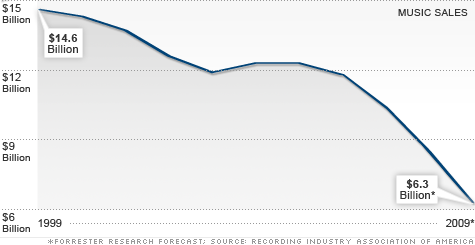Part 1:
Situation: “Brand Y” wants to launch a new product, or increase awareness for an existing one. To make its product seem cutting edge, a massive ad campaign features music from a hip, new and unknown indie band.
Outcome: Ads become ubiquitous and the under-the-radar indie band is catapulted into the mainstream and exposed to a host of new unimagined opportunities for its music.
While this marketing truism is now standard in commercial advertising, it wasn’t so 10 years ago. Back then, brands almost never used music from unknown acts in their promotional campaigns – in fact, the vast majority of songs on TV and radio ads in those days were either custom jingles or well-known pop hits.
Ironically, during the same decade in which music industry sales were cut in half, there was also a dramatic rise in the number of relatively unknown artists who’ve launched their careers in large part because of certain high profile commercial placements.
See:

The reasons why the music business is pushing this trend are clear. However, brands and ad marketers have also realized the value of finding creative voices of authenticity to partner with as well, especially when it comes to penetrating the often fickle and increasingly artsy younger demographics.
What better way to gain credibility with the all-important youth market than for a brand to provide the first point of contact (e.g. a television, internet, or radio spot) between that consumer and his or her new favorite musical act?
A noteworthy example of advertising-as-musical-vehicle is “1234” by Feist in a 2007 iPod Nano ad. Before the commercial, her album The Reminder sold an average of 6,000 units a week, and the song registered only about 2,000 downloads a week. After the commercial aired, the track passed the 73,000 download mark, peaked at No. 7 on Billboard’s Hot Digital Songs Chart, and reached No. 8 on the Hot 100. The Canadian singer became one of the most recognizable new artists around.
[youtube=http://www.youtube.com/watch?v=8qP79rRzzh4]Here’s an amusing parody of the song and commercial on the sketch comedy show MadTV:
[youtube=http://www.youtube.com/watch?v=eF-qX72om5w]But even though Apple may have perfected the art of breaking bands via large-scale product ad campaigns, today’s baby bands are taking more of a buckshot approach to co-branding, rather than putting all their eggs in the proverbial marketing basket of Steve Jobs and Co.
Two great examples are Vampire Weekend and The Black Keys. The bands recently appeared on the Colbert Report where they participated in an epic contest of “sell-out-off.” Host Stephen Colbert tallied up music that appeared in commercials for mega brands such as Zales, Victoria’s Secret, HP, and Tommy Hilfiger:
While music placement in advertising has progressed along the lines of “find a cool song that fits the product, and sync it in an equally cool TV commercial,” the future of commercial music integration looks much more intriguing.
Up next, we’ll look at how Old Navy, Ram Truck, Bud Light Lime and Mountain Dew are blazing new trails when it comes to partnering with indie artists to create original interactive experiences geared toward turning die-hard music fans into loyal customers.
– Mario Davis, Director of A&R